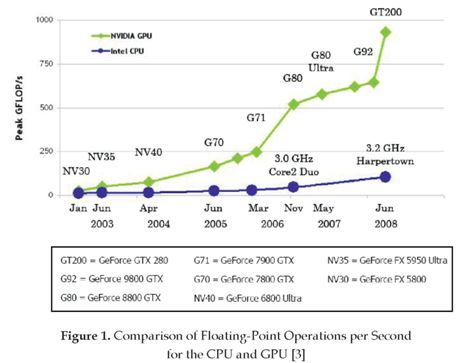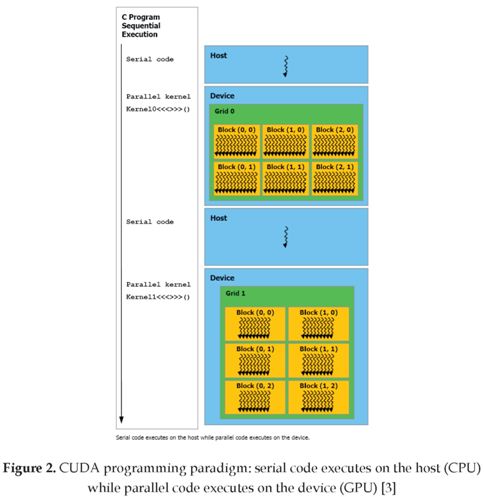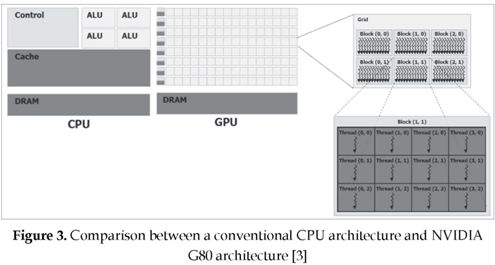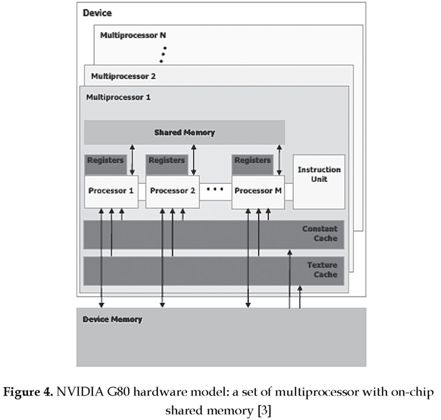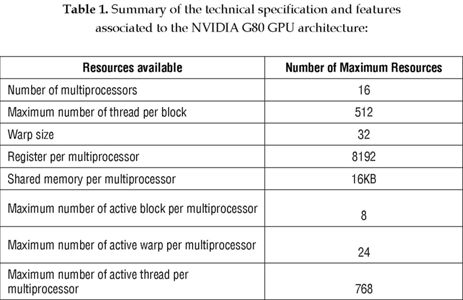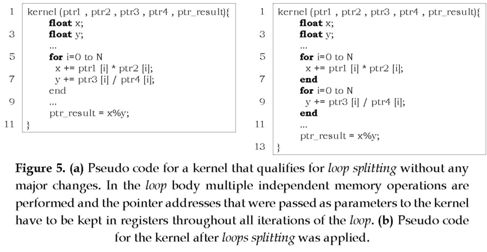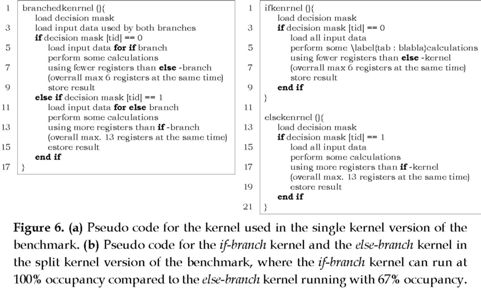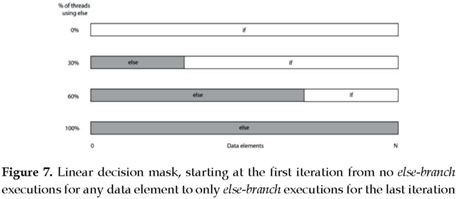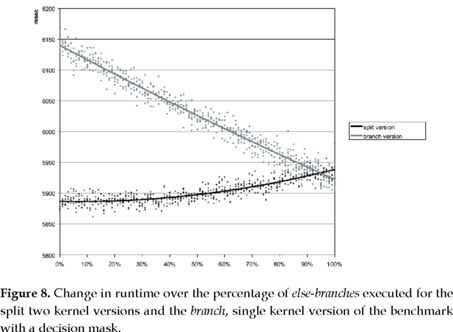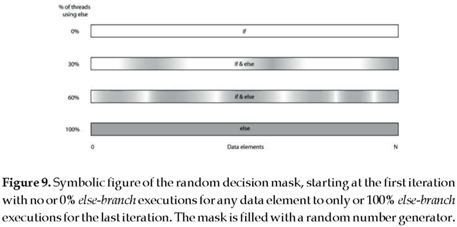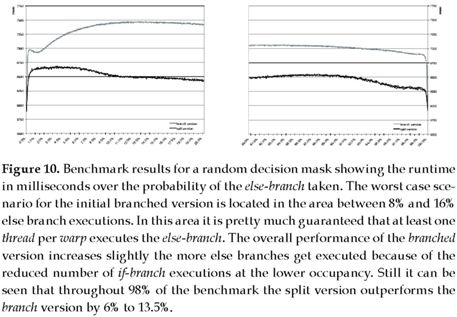Servicios Personalizados
Revista
Articulo
Indicadores
-
 Citado por SciELO
Citado por SciELO -
 Accesos
Accesos
Links relacionados
-
 Citado por Google
Citado por Google -
 Similares en
SciELO
Similares en
SciELO -
 Similares en Google
Similares en Google
Compartir
Ingeniería y Desarrollo
versión impresa ISSN 0122-3461versión On-line ISSN 2145-9371
Ing. Desarro. n.27 Barranquilla ene./jun. 2010
ARTÍCULO CIENTÍFICO / RESEARCH ARTICLE
Impact analysis of conditional and loop statements for the NVIDIA G80 architecture
Análisis del impacto de sentencias condicionales y repetitivas en la arquitectura NVIDIA G80
Snaider Carrillo*
University of Ulster (Londonderry - UK)
Jakob Siegel** Xiaoming Li***
University of Delaware (Newark - USA)
* Beng in Electronics Engineering from Universidad del Norte, Barranquilla (Colombia). MSc in Electronics Engineering from Pontificia Universidad Javeriana, Bogotá (Colombia). PhD Student in Computer Science at University of Ulster (Londonderry - UK). snaidercl@ieee.org
Correspondencia: Carrera 15 N.° 27C-16, Barranquilla (Colombia).
** BEng in Software Engineering from HS Essligen: University of Applied Science (Essligen - Germany). MSc in Electrical and Computer Engineering from University of Delaware (Newark - USA). PhD Student in Electrical and Computer Engineering at University of Delaware (Newark - USA). jsiegel@udel.edu
*** BSc and MSc in Computer Science from Nanjing University (Shanghai - China), and PhD in Computer Science at the University of Illinois at Urbana-Champaign (Urbana-USA). Assistant Professor in the Department of Electrical and Computer Engineering at University of Delaware (Newark - USA). xili@udel.edu
Fecha de recepción: 4 de agosto de 2009
Fecha de aceptación: 11 de febrero de 2010
Abstract
In this paper, we propose two novel techniques to transform control statements so they can be executed efficiently on the NVIDIA G80 architecture. Our techniques called loop splitting and branch splitting smartly increase code redundancy, which might be deemed as "de-optimization" for CPU; but for a GPU framework these techniques improve the occupancy of a program on the GPU device and therefore improve its performance. We demonstrate our optimizations on an artificial benchmark and the results show that these techniques are very efficient and, depending on the problem layout, can lead to an increase in occupancy and a drastic improvement in performance compared to non-split version of the same algorithm.
Keywords: Branch splitting, instruction level optimization, loop splitting, NVIDIA G80 architecture
Resumen
En este artículo se proponen y evalúan dos nuevas técnicas de optimización a nivel de instrucciones enfocadas a hacer un mejor uso de los recursos de tipo hardware en la arquitectura NVDIA G80. Estas técnicas llamadas loop splitting and branch splitting incrementan de forma controlada la redundancia de código, lo cual puede ser considerado como "no óptimo" en una arquitectura convencional como la CPU; sin embargo, en la arquitectura multiprocesador NVIDIA G80, dicha redundancia se ve reflejada en el incremento de la ocupación de sus multiprocesadores y en un aumento del paralelismo de los programas ejecutados en este tipo de arquitectura. Los resultados obtenidos a partir de los bancos de pruebas aleatorios y no aleatorios realizados en esta investigación muestran que estas técnicas incrementan la ocupación y el paralelismo de la arquitectura NVIDIA G80 comparado con la ejecución de la versión non-splitting del mismo algoritmo.
Palabras clave: Arquitectura NVIDIA G80 „ branch-splitting, loop-spliting, Optimización a nivel de instrucciones.
1. INTRODUCTION
Scientific computations have always been in need of all the computational power they can get. However, high computational power is traditionally very expensive and, if available, its full usage requires extensive programming efforts. The limited availability of computational power to the High-Performance Computing (HPC) community has changed recently. Off-the-shelf hardware such as IBM Cell processors in video game consoles (e.g. PlayStation III), and Graphic Processing Units (GPUs) in consumer PCs provides equivalent or even higher computational power than what is offered by the traditional CPU-centered high performance computing solutions (see figure 1). Until recently, it was a challenging task to implement an algorithm to run on a GPU, especially because of the functionality of such a device was plainly geared toward graphics acceleration, and did not offer an interface to perform non graphics related operations. Hence, scientific applications had to be implemented using functions and APIs such as OpenGL that are intended only for graphic tasks. In the past, this fact and the lack of downward compatibility of newer generations of graphic hardware greatly restrained the usage of GPUs for scientific computing [1], [2].
Nowadays, the introduction of the NVIDIA G80 architecture and the accompanying Compute Unified Device Architecture (CUDA) driver and C language extension [3] make this computational power of GPUs easier to utilize, taking the General-Purpose Computing on Graphic Processor Units (GPGPUs) programming to a higher level (see figure 2) [2], [3]. The CUDA driver and C language extension simplify the usage of the GPU as a co-processing device. However, even though the problem of writing a program that can work on a GPU seems to have been solved, the question of how to tune a program to make it work well on a GPU is only rudimentary understood and insufficiently investigated. Most notably, the program optimization for GPUs faces two major challenges:
• The GPU memory hierarchy is organized in a radically different way from the organization of the CPU memory hierarchy. Using a GPU, the programmer has to manipulate the access patterns to increase the applications performance. It is the programmer's responsibility to maximize the throughput by optimizing the memory layout, as well as, removing bank conflct in shared memory.
• The classical instruction level optimization must be re-evaluated in the context of the GPU. Instruction level optimizations for the CPU usually assume a program can occupy all CPU resources such as registers. However, the main focus of instruction level optimization for a CUDA program is to conserve hardware resources in order to allow a higher occupancy of the available hardware for all threads.
Within the instruction level optimization, loop and branch statements are of special interest since most of the algorithms that qualify to be implemented in CUDA are flow control based. Furthermore, control statements in a program such as loops and branches pose serious challenges for the efficient usage of the GPGPU resources because those control statements will lead to the serialization of threads and consequently ruin the parallelism and occupancy of the GPU. Even though scientific computation programs typically have few control statements, those can easily become the performance bottleneck of a whole program.
Unlike traditional vector processing units that are inside a general purpose processor, a GPU cannot leave the control statements to the CPU, because a GPU is generally much farther away from the CPU than the vector units, hence fine-grain statement scheduling between a GPU and a CPU is impossible [4]. On the basis of this, we need an effective method to handle the control statements "just-in-place" on the GPUs.
In this paper we present and evaluate two novel instruction level optimizations that help to make better use of the hardware resources of the NVIDIA G80 architecture. These techniques called loop splitting and branch splitting smartly increase code redundancy, which might be deemed as "de-optimization" for CPU; but for a GPU framework these techniques improve the occupancy of a program on the GPU device and therefore improve its performance. We demonstrate our optimizations on an artificial benchmark and our results show that these techniques are very efficient and, depending on the problem layout, can lead to an increase in occupancy and a drastic improvement in performance compared to non-split version of the same algorithm.
The rest of the paper is organized as followed: In Section 2 we present a brief discussion about the related work. In Section 3 we give an overview of CUDA. In Section 4 we present the proposed approach to improve the occupancy and parallelism for the NVIDIA G80 architecture. In section 5 we evaluate the performance of our optimizations on an artificial benchmark. The conclusions are given in Section 6.
2. RELATED WORK
Since NVIDIA published CUDA in 2006, there has been a great interest in many different areas to apply and optimize techniques to use CUDA in an efficient way. Over the past few years the understanding and acceptance for GPGPU programming grew steadily. As a result, we can see many research projects that design new optimization techniques for GPGPUs or study the application of CPU-based optimization to the new context of GPGPUs. Limited by space, here we discuss only a small set of those projects.
Optimization for memory hierarchy is probably most extensively studied in the context of GPGPUs. For instance, loop tiling is probably one of the most important program transformations to improve the cache locality of a program; it has been studied under two different contexts: for the CPU and the GPGPU. The loop tiling for CPU is extensively studied in [5]-[9]. Studies of loop tiling and unrolling also include those that analyze the benefit/overhead ratio and predict the best unrolling factors [10]. On the GPU side, Ryoo et al. [11] study the basic principles of optimization for GPGPUs including loop-level optimization techniques. Moreover, Ryoo et al in [11] present how to define the overall optimization space for GPGPUs by using heuristic. Their technique is shown to be effectively to find the best optimizations for the matrix multiplication on NVIDIA CUDA.
Another important category of GPU-based research projects is the application of the high performance GPUs in real world problems. In [12] the authors give an introduction to a few representative projects of such applications. Finally, Stratton et al in [13] present a unified framework that enable a kernel to be developed only once for one GPGPU architecture but can be automatically ported to other GPGPUs and multi-core architectures [14], [15].
3. CUDA OVERVIEW
CUDA is an NVIDIA's programming model that uses GPUs for general purpose computing. It allows the programmer to write programs in C with a few extensions, which are specific to the CUDA hardware. These extensions allow the programmer to directly access the different levels of the memory hierarchy, which is quite different from the common and well known CPU memory/cache model (see figure 3). In this framework the programmer is responsible to take full advantage of several memory layout techniques, which will manage all levels of the GPU's explicit memory hierarchy.
Occupancy
The NVIDIA G80 GPUs presents a new architecture called SIMT (single-instruction, multiple-thread) [3], allowing the multiprocessor maps each thread to one scalar processor core, and each scalar thread is executed independently with its own instruction address and register state (see figure 4). This is a cost-effective hardware model where groups of up to eight threads will execute the same instruction in a thread processing array for exploiting data parallelism. However, it can be ineffective for algorithms that require diverging control flow decisions, such as those generated from if and switch statements that can significantly impact the instruction throughput if threads within the same warp follow different branches [16].
In some algorithms, threads can be reorganized to avoid divergent control flow, and logical threads within a block can have independent control flow throughout the program. However, for good performance on the GPU hardware, each thread should follow the same control flow or execution trace throughout the kernel code. The NVIDIA G80 GPU architecture executes logical threads in SIMT bundles called warps, but allows for divergence of thread execution using a stack-based re-convergence algorithm with masked execution [16], [17]. Therefore, logical threads with highly irregular control flow execute with greatly reduced efficiency compared to a group of logical threads with identical control flow.
In addition, another important challenge of The NVIDIA G80 GPU architecture is to find the optimal numbers of threads and blocks that will keep the GPU fully utilized. However, the percentage of utilization depend of different factor such as the size of the global data set, the maximum amount of local data that blocks of threads can share, the number of thread processors in the GPU, and the sizes of the on-chip local memories [3]. In order to help developers perform this analysis, NVIDIA provides an Occupancy Calculator, which considers all these factors to suggest the best way to distribute the data along the kernels [2], [18].
To reach the maximum possible number of the 12,288 threads in 128-processor NVIDIA G80 architecture, the compiler should not assign more than about 10 registers per thread. However, in practice the compiler assigns 20 to 32 registers per thread, which limits the practical degree of concurrency, and decreases the occupancy of the kernel, which is defined as the ratio of the number of active warps per multiprocessor to the maximum number of active warps.
4. PROPOSED LOOP AND BRANCH OPTIMIZATION TECHNIQUES
Modifying CUDA kernels in a way to guarantee the highest possible utilization of available computational resources is a major task for the GPGPU programmers. Having a Kernel that runs at 100% occupancy allows for better usage of computational resources and improves the power consumption, is more efficient in hiding memory latencies and therefore gives a better performance. Two well known control structures, such as: loops and branches, can have a major effect on occupancy and the performance of a kernel which hase to be optimized [19].
There are many well known loop optimizations that can be applied to CPU programs as well as to CUDA Kernels. For example loop unrolling, to reduce the overall number of instructions needed and to allow instruction reordering, loop interchange and in some cases even loop tiling might help to improve access to the manually managed shared memory of the device. On the other hand, branches are one of the major factors that bring down the performance of a CUDA kernel if they are used without considering the negative effects on the SIMT architecture. If only one thread in a warp steps through the other branch then all the threads of the warp have to step through the instructions of both branches as it is the case for a common SIMD architecture [20].
In many cases the programmer can optimize the branching in a way that the additional number of instructions is kept low or can organize the input data in a way to guarantee that every thread in a warp has to execute the same branch. In this section we propose two novel techniques that can help to improve the performance of loops that utilize excessive memory operations and branches with different complexity.
Loop Splitting
A loop splitting is a pretty simple optimization to reduce the register pressure of a kernel. Therefore this optimization is limited to kernels that do not reach 100% occupancy because of register usage. If the kernel contains a loop where in the loop body multiple operations are performed and each operation relies on inputs that are stored in different registers (e.g. memory addresses) and at least some of those operations are independent this optimization can be applied. The loops splitting described here is not the same as loop peeling [21] which is also sometimes referred to as loop splitting but is a compiler optimization to remove dependencies or simplified loops.
The purpose of our loop splitting technique is to give the programmer a tool to increase the occupancy of a CUDA kernel and by doing so the overall performance [19]. In figure 5, we can split the loop in two loops, by doing so we only have to keep the parameter values ptrl and ptr2 in registers for the first loop and ptr3 and ptr4 for the second loop. This can be done because all the pointers are parameters passed to the kernel and if we only use those parameters in the loop body, we don't have to load them into registers before. Therefore ptrl and ptr2 are getting loaded into registers when the first loop is executed and ptr3 and ptr4 are loaded when the second loop is executed. This new transformation frees at least 2 registers which can in many cases give an increase in occupancy of up to 33%.
Branch Splitting
As loop splitting, the general idea behind branch splitting is to reduce the usage of hardware resources such as registers and shared memory of a kernel or at least part of the kernel. Branch splitting can be applied for any kernel that does not run with 100% occupancy, works on independent data and contains branching where the branches differ in complexity and therefore in the usage of hardware resources, especially registers or shared memory. This means that if one branch makes excessive usage of registers or shared memory so that the occupancy drops below 100%, the whole kernel will always run with that minimal occupancy even if the branch that leads to the lower occupancy is never executed.
The idea is to split the branches of the initial kernel into two kernels, where one kernel executes only the if-branch and the other kernel only executes the else-branch. The benefit of a two kernel version is that even we have a little overhead from the additional kernel invocation we get an increase in performance since we could increase the occupancy for at least part of the initial kernel [19].
The worst case scenario for using the single kernel approach is when at least one thread per warp steps through another branch as the rest of the threads, because of the SIMT architecture acts in such as way that in this case every thread of a warp has to step through the instructions of all branches and the device can only be utilized to the minimum occupancy defined by the branch with the highest usage of hardware resources. As an example we can see the figure 6a, where the arithmetic calculations are chosen so that the if-branch uses fewer registers than the else-branch. In the split version shown in Figure 6b the if-kernel uses an overall number of 6 registers compared to 13 for the else-kernel. This results in occupancy of 100% for the if-branch and 67% for the else-branch.
Theoretical Analysis of Branch and Loop Splitting
Experiments as the benchmark discussed in the next section have shown that this transformation in many cases can drastically improve performance.
To get an idea of the theoretical speedup for the worst case the following formula can be used:

Where T, is defined as the runtime for the worst case of the branch-version when the instructions of all n-th branches are executed. In ideal conditions, neglecting all optimizations that are applied at hardware level, this T can roughly be expected to be  Where ρ is defined as the occupancy for i-th branch when it runs on its own, ρmm is the occupancy when the branched version gets executed, σis the invocation overhead produced every time a kernel is called, and ti is the runtime of the single branch before the splitting.
Where ρ is defined as the occupancy for i-th branch when it runs on its own, ρmm is the occupancy when the branched version gets executed, σis the invocation overhead produced every time a kernel is called, and ti is the runtime of the single branch before the splitting.
The calculated speedup just gives an idea of what theoretic speedup can be expected if the kernel does not get limited by other factors (e.g. the memory bank conflicts). There are some more factors that might reduce the speedup or prevent this transformation of being applied. As said before, the kernel in its original setup might already have saturated the memory bandwidth where maybe the increased occupancy might help to hide part of the memory latency but as an overall the performance increase for this case might be marginal. The runtime of the single branches also plays a major role, if the kernel that might run with 100% occupancy has a runtime that is much lower than the kernel running with 67%, then the additional occupancy might not outperform the overhead added. As a guideline we can consider the following conditions for a kernel to be considered for a branch splitting [19]:
• A kernel that does not run at 100% occupancy
• A kernel that contains two or more major branches
• A kernel where the branches utilizing a different amount of hardware resources and the branches can be easily separated
5. ARTIFICIAL BENCHMARK Benchmark Design
The benchmark performs arithmetic calculation for every single element in a fixed data set. By creating a decision mask that defines for every single data element which branch is taken, we have full control over the distribution of the if-else-branch kernel executions throughout a run. Every run of the benchmark executes the single-kernel version of Figure 6a and then the split two-kernel version of Figure 6b on a fixed data set of 4 million elements. We are measuring the overall runtime starting from the kernel invocation till the kernel is done for the single kernel version and compare it to the overall runtime starting from the if-branch kernel invocation till the else-branch kernel is completed. This way the measurements also include the host side (CPU) overhead for the additional kernel invocation in order to give a better picture of the overall change in performance.
To show how the distribution and density of which branch is taken effect, we run the benchmark with 2 different layouts of the decision mask: a linear decision mask in Figure 7, which will be explained in the sub-section 5.2, and a random decision mask Figure 9, which will be explained in the sub-section 5.3. Finally, the benchmark runs on an Intel dual core 2.8 GHz with 2GB of ram and two GeForce 8800 GTX GPUs where only one was used for this benchmark.
Layout 1: two section decision mask
The first run is performed with a decision mask that gets filled up from one side. Therefore we have only two sections in the mask: a growing else-branch section and a decreasing if-branch section (see figure 7). For the first iteration not one single thread will execute the else-branch kernel. For the last iteration, every thread executes the else-branch kernel.
The change in performance throughout the iterations is pretty much a connection between the two extreme cases for 0% and 100% else-branch executions in the first and last iteration of the benchmark (see figure 8). This can be explained by looking at what the threads in each single warp are doing.
There is only one warp throughout the whole problem where threads have to take different branches, which is the warp that contains the threads that are working on the boundary between the two sections of the decision mask. All the other warps only execute the if-branch or the else-branch kernel.
The performance differences between the extreme cases for the first and last iteration can be explained by looking at what is being executed and the level of occupancy at this moment. For the first iteration, that is 0% else-branch executions, every thread in the branch-version executes only the if-branch with 67% occupancy because the device has no way to know if all or how many threads in all blocks running in a multiprocessor only take the if-branch. For that reason the device has to consider that there are threads in all blocks that might take the else-branch and therefore the maximum possible occupancy is the one for the worst case. The split version drops out of the else-branch kernel immediately when there is only if-branch kernel executions needed and in this case also only executes the if-branch kernel for every single thread but each multiprocessor is running at 100% occupancy.
For the last iteration, both benchmark versions: branched and split, execute only the else-branch part with 67% occupancy.
Around this point we have the only problem layout where the overhead of the additional kernel invocation and the additional loads needed by the two kernels lead to a lower performance of the split version than the branched version, but since this is only the case for roughly 5% of this very special problem layout, the split version mostly outperforms the branch version of the benchmark.
It should be mentioned that in a case where the programmer knows that the problem will branch with such conditions there are better ways to improve the performance. E.g. by using two kernels with reduced input sets, so that not for every single data element has to be checked if one or the other branch has to be executed and only one kernel works on each section. The next section will discuss a more realistic decision mask with a random distribution.
Layout 2: random decision mask
In most common problems where branching is used, the condition that defines which branch is taken has a more randomized distribution compared to what is discussed in the previous section. To get an idea how branch splitting affects a problem like that, we generated a random decision mask for every possible condition in the branches (see figure 9). The mask is randomly initialized with more values that lead to an execution of the else-branch instead of the if-branch, starting from 0% else-branch executions to 100% else-branch executions. As can be seen, the results for the extreme cases in figure 10 of 0% else-branch executions and 100% else-branch executions are the same as in the previous experiment, but as soon as we step away from those extreme cases we see a drastic drop in performance.
The reason for that is the earlier explained SIMT architecture of CUDA. where as soon as one thread in a warp has to step through the other branch all threads in the warp will execute all the instructions for both branches. In the previous benchmark run, only one warp in the entire system had to do that, the warp that handles the data segment where the decision mask switched form if to else. On the other hand, with this benchmark setup we 22 have an entire different picture. For a data set of 2 (4 million) elements we have 222/32 = 131072 warps, only 1% of the data (41944 elements) has to be handled by the else-branch and in the worst case every element is placed in a different warp, that is 32% of the warps have to step through the instructions of both branches. This happens at both ends of the 0% to 100% run of the benchmark which explains the drastic drop in performance for the first iterations.
For the branched version of the benchmark the performance decreases further the farther we step away from the starting point till we reach the worst case scenarios between 8% and 16%. In these areas we have the highest probability that every warp at least contains one thread that executes the else-branch, forcing every single thread to step through the instructions of both branches. The split version on the other hand has a similar overall behavior except that the initial drop in performance is way not as drastic as for the branched version and throughout the run of the benchmark the performance of the split version does not change as much as for the branch version.
The important part here is that the execution time for the split version, especially for the worst case scenarios, is 14% faster than for the branch version (see figure 8 and figure 10). The explanation for the better performance of the split version again is the SIMT architecture of CUDA in combination with the different needs of resources of the branches. As explained earlier in this section, the if-branch uses fewer registers as the else-branch. In the branched version the kernel can only utilize part of the device since the kernel simultaneously uses up to 13 registers. Therefore a block size of 256 threads per block limits the occupancy of the multiprocessors to 67%. In the split version the else-branch kernel still uses 13 registers and runs at 67% occupancy but the if-branch kernel uses just 6 registers which allows this kernel to fully utilize all the devices computational power by running at 100% occupancy. These facts already explain the increase in performance of the previous benchmark layout, but for the random decision mask this factor becomes way more important in combination with the SIMT architecture.
In the previous non randomized benchmark explained in the sub-section 5.2, all warps except one executed only the if-branch or the else-branch kernel. Now we have a completely different setup. For this benchmark every warp that contains two threads that take different branches will have to execute the instructions of both branches. As said before, in the worst case section between 8% and 16% of probability of the else-branch executions is the highest, because every warp contains at least one or more threads executing in the else-branch. Here we can say that for all 2 threads where each works on one 22 of the 2 elements, the branched as well as the split-version, all instructions of both branches or both kernels have to be executed. The big difference is that the branched version is limited to utilize 67% of the devices resources for both branches, whereas the split version executes the if-branch kernel at 100% and the else-branch kernel at 67%. If we use the equation 1 explained in the sub-section 4.3, we can say that the branches in the original branched version run roughly at the same speed, only if we neglect the overhead and assuming that t =

This represents an average speed-up compared to the worst case scenario which is in the area where 8% to 16% of the threads have to use the branch with the lower occupancy. Till now it is only possible to give an estimate of the speed-up for a problem where the branches are executed in a random fashion distributed equally over the threads. Furthermore the final result may be influenced by the other hardware limitations such as bank conflict in shared memory. Those limitations and how they influence the overall performance still has to be considered for every single problem.
6. CONCLUSION
To run kernels with the highest possible occupancy is one of the major tasks for any GPGPU programmer. Any transformation or optimization that can reduce the usage of hardware resources that reduce the occupancy are a big contribution to the overall performance of a GPGPU program execution. Our loop and branch transformation helps to increase the occupancy and parallelism for some special cases of loops and a more general case of branches.
The loop splitting is an example for a transformation that might seem counterproductive on most other architectures than a GPU, but here where occupancy is a major player in the performance game, it can have a positive impact on the overall performance for the NVIDIA G80 Architecture.
In any case branches are not a good thing to use in any SIMD or SIMT architecture, but for some algorithms there are not that many other efficient ways to implement them without using branching. Therefore optimizing branches in a way that either the number of instructions per branch gets minimized or the input data set reduces the probability of warps where both branches have to be executed is also a major task for GPGPU programmers; especially when we know that in many cases there is no way to prevent both branches from being executed within a warp, and most of this branches differ in complexity and therefore in the usage of hardware resources. In those cases, branch splitting is a promising transformation that can drastically improve the performance of a GPGPU application.
References
[1] M. Woo, J. Neider, T. Davis, and D. Shreiner. OpenGL Programming Guide: The Official Guide to Learning OpenGL, Boston, MA: Addison-Wesly, 2005. [ Links ]
[2] T. Halfhill. "Parallel processing with CUDA: Nvidia's high-performance computing platform uses massive multithreading". Microprocessor Report. Vol. 22, pp.1-8, January 28, 2008. [ Links ]
[3] NVIDIA. Compute Unified Device Architecture Programming Guide. NVIDIA: Santa Clara (CA): NVIDIA, 2007. [ Links ]
[4] E. Kilgariff, R. Fernando. GPU Gem 2. Santa Clara (CA): Addison-Wesly, 2006. [ Links ]
[5] G. Goumas, A. Sotiropoulos, and N. Koziris. "Minimizing completion time for loop tiling with computation and communication overlapping". 15th International Parallel and Distributed Processing Symposium, Apr, 2001. [ Links ]
[6] J. Xue, Q. Huang, and M. Guo. "Enabling loop fusion and tiling for cache performance by fixing fusion-preventing data dependences". In Proc. International Conference on Parallel Processing, ICPP, 2005. pp. 107- 115. [ Links ]
[7] F. Rastello and Y. Robert. "Automatic partitioning of parallel loops with parallelepiped-shaped tiles", IEEE Transactions on Parallel and Distributed Systems, vol. 13, n.° 5, pp. 460-470, 2002. [ Links ]
[8] K. Hogstedt, L. Carter, and J. Ferrante. "On the parallel execution time of tiled loops". IEEE Transactions on Parallel and Distributed Systems, vol. 14, n.° 3, pp. 307- 321, March 2003. [ Links ]
[9] K. Yotov, X. Li, G. Ren, M. Cibulskis, G. DeJong, M. Garzaran, D. Padua, K. Pingali, P. Stodghill, and P. Wu. "A comparison of empirical and model-driven optimization". In Proc. of Programing Language Design and Implementation, June 2003, pp. 63-76. [ Links ]
[10] P. Kisubi, P. Knijnenburg, and M. O'Boyle. "The effect of cache models on iterative compilation for combined tiling and unrolling". In Proc. of the International Conference on Parallel Architectures and Compilation Techniques, 2000, pp. 237-246. [ Links ]
[11] S. Ryoo, C. Rodrigues, S. Baghsorkhi, S. Stone, D. Kirk, and W. Wen-mei. "Optimization principles and application performance evaluation of a multithreaded GPU using CUDA". Proceedings of the 13th ACM SIGPLANSymposium on Principles and practice of parallel programming, 2008, pp. 73-82. [ Links ]
[12] H. Nguyen. GPU Gem 3, Santa Clara, CA: Addison-Wesly, 2007. [ Links ]
[13] J. Stratton, S. Stone, and W. Wen-mei. MCUDA: An efficient implementation of CUDA Kernels on multi-cores. Center for Reliable and High-Performance Computing, 2008. [ Links ]
[14] Open64. http://www.open64.net. [ Links ]
[15] E. Lindholm, J. Nickolls, S. Oberman, and J. Montrym. NVIDIA Tesla: A unified graphics and computing architecture. IEEE Micro, vol. 28, pp. 39-55, 2008. [ Links ]
[16] S. Ryoo, C. Rodrigues, S. Baghsorkhi, S. Stone, D. Kirk, and W. Wen-mei. Optimization principles and application performance evaluation of a multithreaded GPU using CUDA. In Proceedings of the 13th ACM SIGPLAN Symposium on Principles and practice of parallel programming, 2008, pp. 73-82. [ Links ]
[17] J. Stratton, S. Stone, and W. Wen-mei. MCUDA: An efficient implementation of CUDA Kernels on multi-cores. Center for Reliable and High-Performance Computing, 2008. [ Links ]
[18] S. Che, J. Meng, J. Sheaffer, and K. Skadron. A performance study of general purpose applications on graphics processors. The First Workshop on General Purpose Processing on Graphics Processing Units, October, 2007. [ Links ]
[19] S. Carrillo, J. Siegel, and X. Li. 2009. A control-structure splitting optimization for GPGPU. In Proceedings of the 6th ACM Conference on Computing Frontiers. Ischia (Italy), 2009, May 18-20. [ Links ]
[20] Hennessy, D. Patterson. Computer Architecture: A Quantitative Approach, 4 ed. San Francisco, CA: Morgan Kaufmann, MA, 2006. [ Links ]
[21] L. Ravi. "A technique for variable dependence driven loop peeling". In Fifth International Conference on Algorithms and Architectures for Parallel Processing: October 23-25, 2002, Beijing (China). [ Links ]













